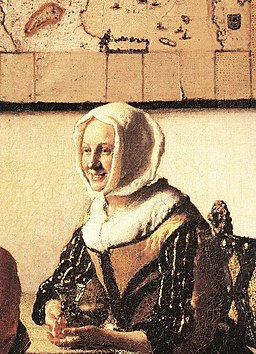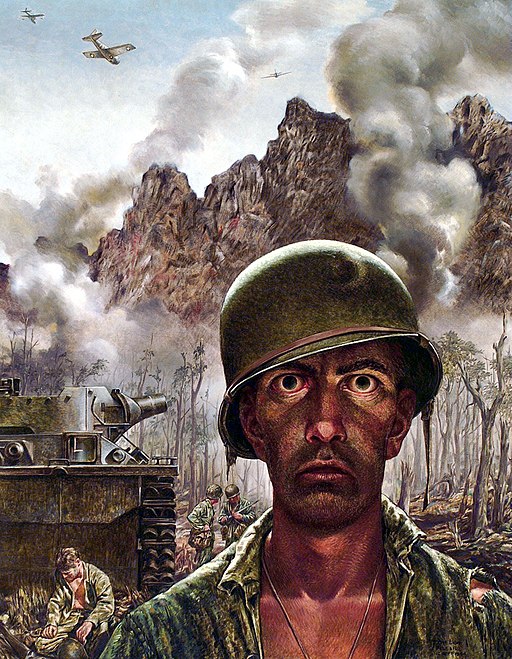
“Officer and Laughing Girl” by Johannes Vermeer depicts a girl in a yellow dress seated at a table facing a man with a large hat. She has a soft light falling on her face, coming from the left-hand side of the painting from an open window.
The man in the painting has his back to the viewer and is mainly in the shadows with his face obscured. He is a cavalier wearing a red coat and an expensive hat, showing his wealth and rank. His hat is wide-brimmed, which was weather-resistant and used for snowy and rainy conditions.
The background includes a large map on the wall. The window and lighting are characteristic of Vermeer’s interior paintings because he used the same room in many of his paintings.
This window is extremely similar to the window in the Girl Reading a Letter and Open Window and the Milkmaid. The glass in the window has variations of color, showing Vermeer’s precision in this painting’s details.
The woman resembles Vermeer’s wife, Catharina Bolnes, who had posed for many of his paintings. With x-ray photographs, art historians can see that Vermeer had initially planned to paint the woman with a large white collar.
This was later changed to show more of her yellow dress. The yellow bodice with braiding has appeared in many of Vermeer’s other portraits. The woman is showing holding a wine glass, usually used for white wine to illustrate her wealth.
The women’s headcover, which was usually worn as an everyday, common dress, was later extended to cover all of her hair and focus attention on her face and expression.

The woman is also wearing a blue apron over her dress, but it is hidden in the shadows of the table. Her dress has been interpreted to mean that the soldier surprised the girl with an impromptu visit during her work.
The meaning of the relationship between the woman and the soldier is unknown. Some art historians believe that it portrays a woman being courted by this soldier. Others suggest that her open hand and smile could be asking for payment of services.
The red coloring in the soldier’s uniform is associated with power and passion, lending an emotional mood to the painting. His rank as an officer is identified by the black sash he wears.
His striking shadowy presence adds drama and mystery to the mood of the composition. Placing the male figure in the foreground is also an artistic device to increase the depth of the overall painting; it is called repoussoir.
Repoussoir
In two-dimensional paintings, repoussoir is an object along the right or left foreground that directs the viewer’s eye into the painting by framing the composition’s edge.
This artistic technique became popular with Mannerist and Baroque artists and is found frequently in Dutch seventeenth-century paintings.
Caravaggio often used this technique, and Vermeer may have learned it from a Caravaggist’s painting or some other influential painter.
Vermeer’ Maps
Johannes Vermeer is the favorite painter of many map historians. Several of his painting illustrate maps hanging on walls or globes standing on tables or cabinets.
Vermeer painted these cartographical objects with such detail that it is often possible to identify the actual maps he used as a model in his art.
Vermeer depicted as wall decorations in three of his paintings, a map of Holland and West Friesland that no longer survives. However, the map’s existence is documented in archival sources and a second edition published by Willem Blaeu in 1621.
Vermeer details this map as a wall decoration in this painting. Bright sunlight bathes the large map on the wall showing Vermeer’s realism. The wall map is easily identifiable as Blaeu’s 1621 map of Holland and West Friesland with its characteristic design, decoration, and geographic content.
Johannes Vermeer, “Officer and Laughing Girl”
Johannes Vermeer
Johannes Vermeer (1632 – 1675) was a Dutch Baroque Period painter who specialized in domestic interior scenes of middle-class life.
He was a moderately successful painter in his lifetime. However, he was not wealthy, leaving his wife and children in debt at his death.
There are only thirty-four paintings by Vermeer, and they are challenging to date. Vermeer painted mostly domestic interior scenes, and most of his pictures are set in the rooms of his house in Delft.
There are similar furniture and decorations in various arrangements in his domestic scenes, and his art often portrays the same people.
He produced relatively few paintings compared to his contemporaries. Art historians mainly overlooked Vermeer’s works for several centuries after his death.
However, his reputation has skyrocketed in the last few hundred years, and he is particularly renowned for his masterly treatment and use of light in his work.
Officer and Laughing Girl
- Title: Officer and Laughing Girl
- Also: Officer With a Laughing Girl
- Dutch: De Soldaat en het Lachende Meisje
- Artist: Johannes Vermeer
- Year: 1657
- Type: Oil on canvas
- Period: Dutch Golden Age
- Dimensions: Height: 50.5 cm (19.8 in); Width: 46 cm (18.1 in)
- Museum: Frick Collection
“Officer and Laughing Girl” by Johannes Vermeer
Johannes Vermeer
- Artist: Johannes Vermeer
- Born: 1632 – Delft, Dutch Republic
- Died: 1675 (aged 43) -Delft, Dutch Republic
- Nationality: Dutch
- Movement Dutch Golden Age, Baroque
- Notable works:
- Girl with a Pearl Earring
- The Concert
- Lady at the Virginal with a Gentleman
- Woman with a Pearl Necklace
- The Milkmaid
- The Little Street
- The Allegory of Faith
- The Music Lesson
- The Lacemaker
- The Geographer
- Girl Reading a Letter at an Open Window
- A Young Woman standing at a Virginal
- A Lady Writing a Letter
- The Procuress
- Officer and Laughing Girl
Vermeer’s “Officer and Laughing Girl”
Virtual Tour of the Frick Collection
- “Saint Francis in the Desert” by Giovanni Bellini
- “Sir Thomas More” by Hans Holbein the Younger
- “Portrait of Thomas Cromwell” by Hans Holbein the Younger
- “Saint Jerome as Scholar” by El Greco
- “The Polish Rider” by Rembrandt
- “Harmony in Pink and Grey” by James Abbott McNeill Whistler
- “Officer and Laughing Girl” by Johannes Vermeer
Vermeer’s “Officer and Laughing Girl”
~~~
“Opportunity creates desire.”
– Dutch Proverb
~~~
Photo Credit: 1) Johannes Vermeer [Public domain], via Wikimedia Commons
Popular this Week








 Sponsor your Favorite Page
Sponsor your Favorite Page SEARCH Search for: Search Follow UsJoin – The JOM Membership Program
Sponsor a Masterpiece with YOUR NAME CHOICE for $5
Share this:
- Tweet
